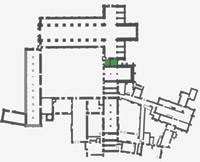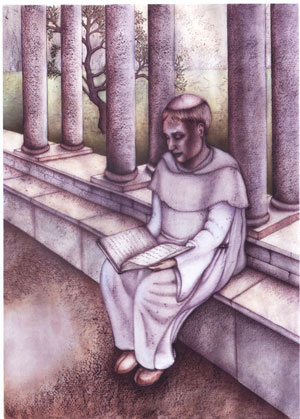|
|
You are here:
 The library
The library
 (1/1) (1/1) |
Books that were used in the church, refectory,
infirmary and cloister were kept in a cupboard, the armarium, under
the auspices of the precentor
and succentor. At
Kirkstall, the books which the monks read each day in the cloister
were probably stored in the recess situated in the north part of
the east alley. There was also a library at the abbey. This was
originally housed in the closet to the north of the chapter-house,
but was later moved to the passage south of the parlour, where the
first day-stairs to the monks’ dormitory had been.
Artist's impression of a monk reading in
the cloister
© Cistercians in Yorkshire
<click to enlarge>
 |
At the start of Lent each monk was given a book
he was to read thoroughly that year during the daily period allocated
to reading. He was not to keep his book overnight but return it
to the book cupboard. The monks sat on stone benches in the north
walkway of the cloister and read aloud, but quietly. Nobody was
to leave the cloister during reading time and the monks were to
make sure that their hoods did not cover their faces so that it
was clear they had not fallen asleep.
| The monks spent more time reading in winter
and at Lent, and less time working; on Sundays they read during
periods normally spent working as well as in the reading time. |
Whilst there is no list of the books which belonged
to Kirkstall, we do know that when the community dispersed after
the dissolution
of the house in 1539 Edward Heptonstall, a former member of the
community, took with him the abbey’s library. In his will
of 1558 Edward stipulated that the books which had hitherto belonged
to Kirkstall and now stood in a box at the end of his bed should
pass to his nephew, who studied at school;(1)
if the abbey, however, reconvened his executors were to return the
books to their former home.(2) A number
of Kirkstall’s books survive and represent a wide range of subjects.
They include theological works, histories, beastiaries, grammatical
works and travel writings. (3)
<back><new section>
|







 (1/1)
(1/1)